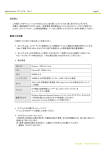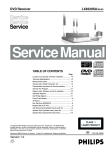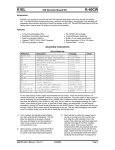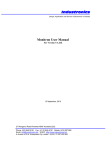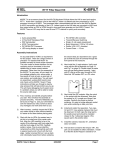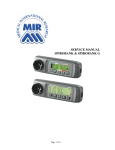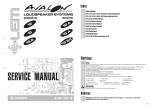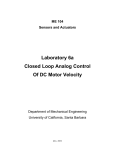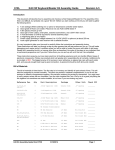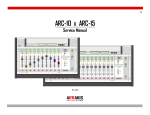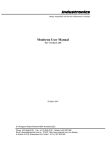Download EFRATOM LPRO 101 Repair Guide
Transcript
EFRATOM LPRO-101 Repair reference guide By Fred de Vries, PE1FBO, 2008 Revision 2, August 2008, © PE1FBO LPRO repair reference guide 1 Contents Brief specs .....................................................................................................4 Rubidium lamp...............................................................................................4 Temperature controlled assemblies...............................................................5 17 and 14 Volts section .................................................................................6 5 volts filtering................................................................................................7 VCO and input protection diodes ...................................................................8 VCO section (20MHz)...................................................................................8 Lamp exciter diagram ....................................................................................9 Rb cell connections (SRD and C-field) ........................................................10 SRD Bias (Step Recovery Diode) ................................................................10 Rb cell connections (Thermistor and Photocell)...........................................11 C field adjustments ......................................................................................12 Possible faults on the unit. ...........................................................................13 Note on replacement of the Rb cell heater transistors .................................14 Tantalum caps .............................................................................................14 Location of R705 and R731 .........................................................................14 Lamp heater diagram sub 1 .........................................................................15 Lamp heater diagram sub 2 .........................................................................16 SMD diode reference...................................................................................17 SMD diode reference by SMD code ............................................................17 SMD transistor reference by SMD code ......................................................17 SMD IC reference ........................................................................................17 Tuning the unit .............................................................................................18 Efratom Rubidium synthesizer schema .......................................................20 Hyperfine resonance frequencies according to NIST...................................20 LPRO repair reference guide 2 Fig 1, Connections LPRO repair reference guide 3 Brief specs Input voltage 24 V DC. (19 .. 32V) Input current when cold is about 1.25 Amp, when the lamp ignites it becomes 1.19 Amps. Input current when warm is 0.35 .. 0.45 Amp Time to lock when cold is 3 to 5 minutes Rubidium lamp Fig 2, Rubidium lamp When the rubidium lamp section reaches 40 to 60° Celcius it ignites, you will see the purple light coming from the back of the lamp. Mind you, that when stray light (50Hz or 60Hz) enters the rubidium cell, the whole unit starts to behave very strange, so be aware of this! Lamp voltage (pin 5) can be as low as 3 Volts, below 3 volts an atomic lock becomes difficult. Healthy units are ranging from 6 to 9 Volts. LPRO repair reference guide 4 Temperature controlled assemblies IRFU220 MJE802 IRFU220 Fig 3, Temperature controlled assembly The Rubidium lamp housing is about 101° Celcius The Rubidium cell is about 71° Celcius The official temperatures (according to the manual) are 110° C for the lamp, and 79° C for the Rb cell. The housing of the heated assemblies measures lower. Both samples had this. It is also depending where you measure the temperature. The base plate needs to be mounted on a heat sink to prevent loss of lock and thermal runaway of the internal electronics. As a test, you can operate the unit without heat-sink for about half an hour to check if the electronics work reliable at higher ambient temperatures. The TO202 heater transistor is a MJE802 (NPN darlington, 4A, 40Watt), this can be replaced with an BD679 or BD681. The TO251 transistors on the lamp and Rb-cell are IRFU220 MOSFETS, 4.6A/200V, 40 Watt. They can be replaced with an IRFU420 or STD3NB30 The Rb lamp exciter transistor is an MRF160, it’s a MOSFET from Motorola. Ft 500 Mhz, 4W, 28 volts. A possible substitute could be the PD57006 from ST LPRO repair reference guide 5 17 and 14 Volts section Ceramic C 2N6490 4u7/35V 7805 Fig 4, 17 Volts section and 14 Volts section Power transistor Q106 is originally a 2N6490, it is a 15Amp, PNP, low hfe type. It can be replaced by an MJE2955T or BD912 if faulty. The collector (mounting tab) of Q106 should be at 17.0 Volts (to GND) Q106 is isolated from the chassis. The additional black capacitor is 1uF/50Volts ceramic. I had to remove the one on the back side, which was suspected to be short at higher temps. There is not enough clearance on the back side of the PCB to have it fitted there. The capacitor C116 is a tantalum one, 4.7uF/35V The positive terminal of this capacitor is about 14.4 Volts (to GND) The voltage regulator VR102 is an 7805, it’s output is at 5 Volts (to GND) LPRO repair reference guide 6 5 volts filtering Fig 5, 5 Volts filtering The two SMD tantalum capacitors can be replaced by SMD tantalum ones of a different value. The original ones where 68 uF/16Volts. The new ones I used are 33uF/16 Volts. The positive terminal of C419 is about 4.6 Volts, the other cap’s voltage is about 4.4 Volts (to GND) Both are used to filter the 5 Volts supply. LPRO repair reference guide 7 VCO and input protection diodes Fig 6, input protection diodes and VCO Both diodes CR101 and CR 106 (F101) are SMBYW02 diodes, with a forward voltage drop of 650 mV. Both anodes are connected to the input of 24 Volts, the cathode is 23.35 Volts. VCO section (20MHz) Oscillator VCO range is rather big +/- 150 Hz for the 10Mhz output. 9.999 850 .. 10.000 180 Hz Total time for a complete scan takes about 105 seconds. (60s ramp up, 45s ramp down) The internal VCO works on 20MHz. The 20 MHz crystal is housed in the round package with heat-sink on it. LPRO repair reference guide 8 Lamp exciter diagram Fig 7, Diagram of Rb lamp exciter LPRO repair reference guide 9 Rb cell connections (SRD and C-field) C-field coil connection RF to cavity Fig 8, Rb cell connections SRD bias pot SRD Bias (Step Recovery Diode) The SRD bias potentiometer is typical set between 1.5 and 4 kOhms If you disconnect the yellow coax cable you can measure the SRD forward voltage drop of 0.7 Volts (center to shield). LPRO repair reference guide 10 Rb cell connections (Thermistor and Photocell) Thermistor connection Photocell connection Fig 9, Rb cell connections LPRO repair reference guide 11 C field adjustments Q10, PZT2222 R126 R116 Fig 10, C field resistor Frequency 9.999.999.908 9.999.999.964 9.999.999.976 10.000.000.002 10.000.000.050 10.000.000.165 Resistor value R126 >100k 6k2 5k2 4k2 3k2 2k2 With increasing current trough the C field coil, the frequency increases. By adapting R126, you can tune the unit with potmeter R116 to exactly 10 MHz The C field coil is approx. 18 Ohms Q10 is a PZT2222A, P1F marking, This is a 2N2222 in SOT223 SMD package. LPRO repair reference guide 12 Possible faults on the unit. Quote from Antonio, I8IOV Before inspecting the lamp, I suggest the following checks: -Check that the lamp housing gets VERY hot in about 1 minute (100°C). -Check that the physics unit (on the other side of the foam) gets hot too (70°C). -Check the presence of the RF field. You could use a counter. Using a link of one turn of wire, check if you can read a frequency of about 70 (or 140, second harmonic) MHz approaching the link to the MRF160 power mosfet (if you read 60 MHz you are picking up the field of the physics unit, not the field for lamp, then orient better the link). If you don't see the signal, check the transistor on board. In one case I've found it shorted. If the transistor seems OK, check resistors in the vicinity, even on the upper side of the board. In one case I've found R705 (bottom, 100K) interrupted. It should read (onboard) about 82K. If the lamp assembly doesn't heat, check R731 (bottom of PCB) In one case I had a faulty lamp. It can be inspected quite easily. Unlock the hexagonal nut and unscrew the lamp, taking note of how much it protruded from the assembly. Don't touch the lamp with fingers. A good lamp has a delicately brownish glass, a lamp which leaked has transparent glass with some small white pigments. It you tried turning the lamp assembly trimmer in order to increase lamp volt, you could have "forced" it causing the rotation of its hot (not ground) lead and possible short on the coil inside the lamp assembly. I would say all 100k resistors of this size on the board are suspect. They are of the 0603 SMD size, and marked with 104 (The smallest parts on the board) If there is a problem with the heating of the Rb cell, check if the emitter of the MJE802 is at 12 volts. This is about half the supply voltage, and follows the input voltage. The voltage over the current sense resistors (backside) is about 300mV. This is when the Rb cell is cold. There are 3 1.2Ohm resistors in parallel. Current is 850 mA. Voltage on the gate of the IRFU220 when stabilised is about 4.4 volts, on the source it is 70 mV. Drain voltage is 12 Volts. If there is a problem with the lamp heater, you could check if the voltage over the 2 Ohms resistor (backside) is about 0.4 Volts, this corresponds to 200mA. LPRO repair reference guide 13 Note on replacement of the Rb cell heater transistors Efratom has used a fusing kind of isolation pad to mount both heater transistors. This results in a very low thermal resistance from transistor case to the aluminium base. If you replace the transistors it is important to restore the original low thermal resistance. With an increased thermal resistance, the lock time increases as well and the MTBF of the unit is also negatively affected since the junction temperature of both heater transistors will be higher. Tantalum caps On an old unit, the tantalum caps have possibly a high ESR or are completely open. I would replace them with new ones since the units run at high temperatures and this has an accelerated aging effect on the tantalum caps. Location of R705 and R731 Fig 11, Location of R705, R731 LPRO repair reference guide 14 Lamp heater diagram sub 1 Fig 12, Lamp heater diagram sub 1 LPRO repair reference guide 15 Lamp heater diagram sub 2 Fig 13, Lamp heater diagram sub 2 LPRO repair reference guide 16 SMD diode reference CR101 CR106 or F101 CR102 SMBYW02-100 (BYW02) SMBYW02-100 SMD CODE ER10 ?? SMD diode reference by SMD code 5D MMBD914 (1N914) SMD transistor reference by SMD code 1P P1F 1JA MMBT2222 A PZT2222 A MMBT2369 A SMD IC reference U101 U102 U103 U201 U202 U203 U204 U301 U302 U401 U402 U403 U501 U701 U702 VR101 VR103 VR701 LMC7101 AIM5X LMC6482 IM LMC6482 IM LMC6484 IM LMC6484 IM MC14053 B LMC6484 IM LMC6484 IM LM615 IM 74AC08 74AC74 LMC7101 AIM5X MAX709 M TLC2272 TLC2272 LP2951 CM REF02 C LM285 LPRO repair reference guide (TLC272) (TLC272) (TLC274) (TLC274) (TLC274) (TLC274) 17 Tuning the unit Once you have a locked unit you can tune the SRD bias and the 6.8 GHz cavity. Allow the unit to warm-up for 10 minutes. You can only do this after a lock has been established. If you don’t have a lock, you probably make things worse by adjusting the settings on the unit. Fig 14, Test point J5, corner pin LPRO repair reference guide 18 Fig 15, Cavity tuning 6.8 GHz SRD bias pot Fig 16, Wave form on J5 Tune both adjustments for maximum Vpp LPRO repair reference guide 19 Efratom Rubidium synthesizer schema A part) 10 MHz * 6 = 60 MHz 114 * 60 MHz = 6.840 GHz B part) 10 MHz / 2 = 5 MHz 5 MHz / 16 = 0.3125 MHz 5 MHz XOR 0.3125 MHz = 5.3125 MHz A and B are mixed, one of the components is 6.840 - 0.0053125 = 6.834 687 500 GHz Hyperfine resonance frequencies according to NIST Rubidium = 6.834 682 608 GHz Hydrogen = 1.420 405 752 GHz Caesium = 9.192 631 770 GHz Difference of frequency (NIST measure and Efratom synth.) is due to buffer gas in the Rb cell, that has a positive offset on the resonance frequency LPRO repair reference guide 20




















